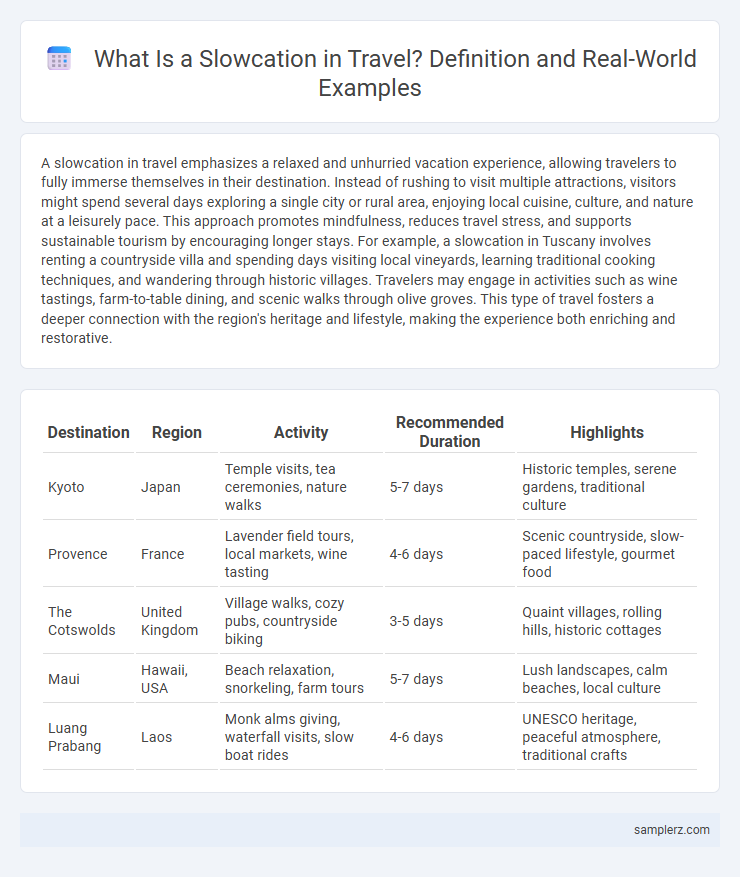A slowcation in travel emphasizes a relaxed and unhurried vacation experience, allowing travelers to fully immerse themselves in their destination. Instead of rushing to visit multiple attractions, visitors might spend several days exploring a single city or rural area, enjoying local cuisine, culture, and nature at a leisurely pace. This approach promotes mindfulness, reduces travel stress, and supports sustainable tourism by encouraging longer stays. For example, a slowcation in Tuscany involves renting a countryside villa and spending days visiting local vineyards, learning traditional cooking techniques, and wandering through historic villages. Travelers may engage in activities such as wine tastings, farm-to-table dining, and scenic walks through olive groves. This type of travel fosters a deeper connection with the region's heritage and lifestyle, making the experience both enriching and restorative.
Table of Comparison
| Destination | Region | Activity | Recommended Duration | Highlights |
|---|---|---|---|---|
| Kyoto | Japan | Temple visits, tea ceremonies, nature walks | 5-7 days | Historic temples, serene gardens, traditional culture |
| Provence | France | Lavender field tours, local markets, wine tasting | 4-6 days | Scenic countryside, slow-paced lifestyle, gourmet food |
| The Cotswolds | United Kingdom | Village walks, cozy pubs, countryside biking | 3-5 days | Quaint villages, rolling hills, historic cottages |
| Maui | Hawaii, USA | Beach relaxation, snorkeling, farm tours | 5-7 days | Lush landscapes, calm beaches, local culture |
| Luang Prabang | Laos | Monk alms giving, waterfall visits, slow boat rides | 4-6 days | UNESCO heritage, peaceful atmosphere, traditional crafts |
Embracing the Slowcation: What It Means for Modern Travelers
Embracing the slowcation means modern travelers prioritize immersive, unhurried experiences over rushed itineraries, allowing for deeper cultural connections and mindful relaxation. Destinations like Tuscany's countryside or Japan's ryokan retreats exemplify slowcations, offering opportunities to savor local cuisine, traditions, and natural landscapes. This travel approach enhances well-being by reducing stress and fostering genuine engagement with the environment and communities.
Top Slowcation Destinations Around the World
Top slowcation destinations around the world include the serene Amalfi Coast in Italy, where travelers enjoy leisurely strolls along picturesque cliffs and taste local cuisine at a relaxed pace. Japan's Yakushima Island offers tranquil forest hikes and hot spring baths, ideal for immersing in nature without the rush of typical tourism. The peaceful countryside of Provence in France invites visitors to explore lavender fields and quaint villages, providing a perfect slow-paced retreat for rejuvenation.
Unique Slowcation Experiences Every Traveler Should Try
Experiencing a slowcation in the serene rice terraces of Bali offers travelers immersive cultural interactions and mindful relaxation away from bustling tourist hotspots. Exploring the Scottish Highlands by foot at a leisurely pace reveals hidden lochs, ancient castles, and folklore-rich villages, enhancing deep connection with nature and history. Participating in a traditional tea ceremony in Uji, Japan, provides a meditative experience blending heritage appreciation and personal tranquility.
How to Plan the Perfect Slowcation Itinerary
Design a slowcation itinerary by selecting a single destination and allowing ample time to explore local culture, cuisine, and natural surroundings at a leisurely pace. Prioritize activities that encourage relaxation, such as visiting serene beaches, hiking gentle trails, or enjoying spa treatments, ensuring a balance between rest and exploration. Incorporate flexible scheduling to accommodate spontaneous discoveries and minimize travel stress for a truly rejuvenating experience.
Benefits of Choosing Slowcation Over Fast-Paced Travel
Slowcations prioritize relaxation and immersive local experiences by encouraging travelers to stay longer in one destination, fostering deeper cultural connections and reducing travel stress. Choosing slowcation over fast-paced travel enhances mental well-being, supports sustainable tourism, and allows for more meaningful interactions with local communities. This approach also minimizes carbon footprints by limiting frequent transportation, contributing to eco-friendly travel practices.
Slowcation Stories: Inspiring Real-Life Examples
Slowcation stories showcase travelers immersing themselves in local cultures by spending extended time in serene destinations such as coastal villages or mountain retreats, prioritizing mindfulness and rest over rushed sightseeing. Real-life examples include exploring artisanal crafts in small towns, savoring regional cuisine in family-run eateries, and engaging in nature walks that promote mental wellness and sustainable tourism. These experiences highlight the growing trend of slow travel as a transformative way to deepen connections with both place and community.
Local Immersion: Connecting with Communities on a Slowcation
Engaging in local markets, participating in traditional cooking classes, and volunteering with community projects offer authentic experiences that deepen cultural understanding during a slowcation. Staying in locally-owned accommodations enhances genuine interactions with residents and supports the regional economy. These immersive activities promote sustainable travel and foster meaningful connections beyond typical tourist encounters.
Eco-Friendly Travel: How Slowcations Support Sustainability
Slowcations promote eco-friendly travel by encouraging extended stays in local or nearby destinations, reducing carbon emissions associated with frequent flights. Choosing accommodations with green certifications and participating in activities that support local ecosystems help conserve natural resources and biodiversity. Emphasizing mindful travel choices, slowcations minimize environmental impact while boosting the sustainability of regional communities.
Budget-Friendly Slowcation Ideas for Every Traveler
Exploring local destinations by camping or renting a cabin offers a budget-friendly slowcation option that allows travelers to immerse themselves in nature without overspending. Visiting nearby towns to experience cultural events, local cuisine, and historical sites provides an enriching yet affordable way to unwind. Emphasizing public transportation or bike rentals reduces transportation costs while promoting sustainable travel choices perfect for budget-conscious travelers.
Tips for Transitioning from Traditional Trips to Slowcations
Embrace slowcation by prioritizing local experiences over rushing to multiple destinations, allowing for deeper cultural immersion and personal relaxation. Choose accommodations that encourage mindfulness, such as eco-lodges or countryside B&Bs, to enhance connection with nature and local communities. Plan flexible itineraries with ample downtime to fully absorb surroundings, reducing travel stress and promoting rejuvenation.

example of slowcation in travel Infographic
 samplerz.com
samplerz.com